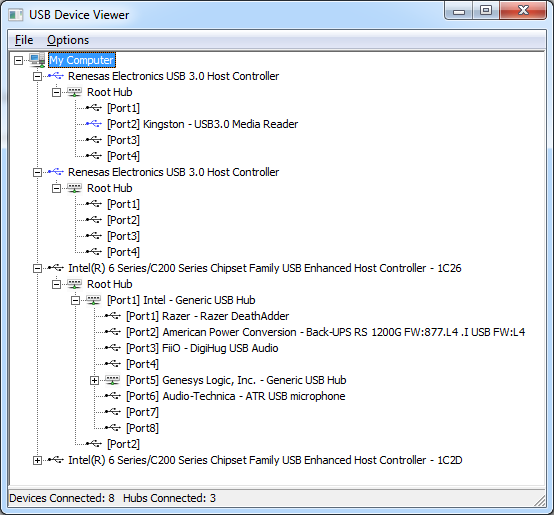Managing USB bandwidth with USBView
USB is mostly plug and play - you get your device, put it into a port and you're done (with perhaps a driver install at the end). While this is fine for most devices, once you start using higher bandwidth devices like webcams, capture cards, microphones or headsets, managing your USB bandwidth becomes important. Each USB port on your PC is attached to a particular USB controller. The controller has limited bandwidth, so if you put a lot of high bandwidth devices on a single controller, you can experience various bandwidth related issues.
Thankfully it's very easy to fix USB bandwidth issues - simply move your devices to different ports. Microsoft have created a program called USBView which I've modified and posted below which lets you view all your USB controllers and see which devices are connected to which controller. It auto refreshes when a device is added or removed, so you can see exactly which ports on your PC correspond to which USB controller.
Symptoms of USB bandwidth overload
Video frame drops / corrupted video / low FPS
Audio static / crackling / dropouts
Synchronization / timing issues (eg video desyncing from audio)
Unresponsive input devices
PC freezes / crashes / blue screen
USB devices disconnecting / reconnecting
Using USBView
Download USBView (145 KB) and run it. You should see something like the above. You can see that this system has four USB controllers, two from Renesas and two from Intel and that almost all of the devices are connected to a single Intel controller. If a webcam was added, this system would likely experience issues with all the USB devices being on the same controller. It turns out that the empty Intel controller belongs to the front panel USB ports, so by connecting the webcam there it would not cause any issues.
What to move
Look to move these kinds of devices to their own controller, listed in terms of bandwidth (highest to lowest):
Video capture cards
Web cameras
Ethernet adapters
Wireless adapters
Microphones / headphones / headsets
Mice / keyboards / other input devices
Other options
Some motherboards may come with USB pins that aren't physically connected to anything. If you have a large amount of USB devices, you could buy additional back panel brackets to make use of these additional headers, for example this USB 3 bracket or this USB 2 bracket.
You can also order a PCI Express expansion card that provides USB ports directly attached to the PCI-E bus. These kinds of cards bypass any motherboard controller limitations and provide the best bandwidth and connectivity, but are more expensive. This StarTech 4 Port 10Gbps USB 3.1 card will provide more than enough bandwidth for even the most demanding capture devices, or the Sonnet Allegro Pro which uses the same chipset but provides more power per port (1.5A).
Not all controllers are created equal
Most motherboards will come with a variety of USB 2 (black) and USB 3 (blue) ports. It's important to know whether the ports are directly controlled by your motherboard chipset (native USB) or provided by a 3rd party add-on chip (eg ASMedia, VIA, NEC, Renesas, etc). Native USB ports will generally give you the best experience with fewer driver issues or other problems. Native ports can be identified by their name - if you have an Intel chipset, look for Intel USB controllers for example. Try to avoid putting high bandwidth devices on 3rd party ports for the best results.
For USB 3 devices, it's especially important that you have up to date USB drivers. Look on your chipset manufacturer's website (eg Intel) for the latest USB drivers for your particular chipset.
Disclaimer: I am a participant in the Amazon Services LLC Associates Program, an affiliate advertising program designed to provide a means for sites to earn advertising fees by advertising and linking to amazon.com. If you purchase the products linked on this page through Amazon, I may receive a commission. These products are my personal recommendation and my choice is not influenced by the associates program.
